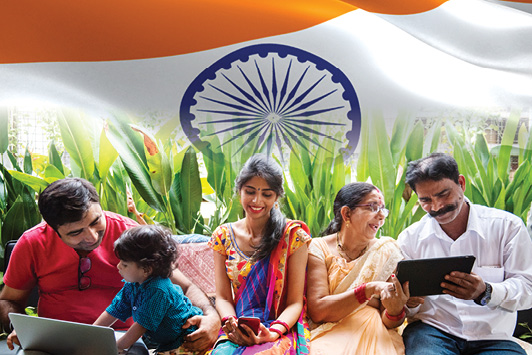
The impact of
e-commerce is starting to make itself felt in India’s retail sector. In 2017,
the online jewelry market in India amounted to under $200 million, representing
0.25% of the country’s total jewelry retail sector, according to Ankur Bisen,
senior vice president of management consulting firm Technopak. “By fiscal year
2020, it is expected to be around $1 billion, and it will capture around 1% to
1.5% of the Indian jewelry retail market.”
Those may sound like small
numbers, but the industry’s potential shouldn’t be underestimated. The major
players in this field are working to educate and lure customers to shop online
for their next piece of jewelry. The big names currently ruling the online
jewelry space are BlueStone and CaratLane — both of which are investor-driven.
Titan Co. Ltd. (part of the Tata Group) holds a 62% stake in CaratLane, while
BlueStone has considerable backing from various companies, including from
industrialist and former Tata Group chairman Ratan Tata.
While BlueStone and CaratLane
both have a strong offline presence, operating stores across India, the
high-profile investment in their online offering is telling — especially
considering that the Tata Group already has its own jewelry brand, Tanishq.
‘Gradually
shedding inhibitions’
In general, the
average Indian customer is “agnostic” about buying jewelry online, says
BlueStone founder and CEO Gaurav Singh Kushwaha. “When people wish to buy a
product, they will purchase it regardless of the medium.”
Nonetheless, he continues,
“since jewelry is a tactile category, customers generally prefer to look and
try them on before making a purchase. We have noticed over the last three years
that people are gradually shedding their inhibitions and are beginning to trust
online platforms as a convenient and safe mode for jewelry shopping. This is
evident from the industry’s growth statistics in recent times.”
To wit, BlueStone is poised
to cross the INR 10 billion (approximately $153.3 million) mark in 2019.
Today’s
digital shopper
CaratLane’s online
customer base is “comparatively younger, and typically someone who has already
made purchases in other categories like books, clothes, electronics, etc.,”
explains Atul Sinha, the company’s senior vice president of marketing. “Many of
them also buy online for gifting to others, since it offers much more
convenience to them and can be shipped directly to the recipient.”
Most of the jewelry that’s
selling on the web caters to fashion and niche daily wear, says Bisen, adding
that “diamond jewelry occupies close to 70% to 80% of the market share online.”
Kushwaha confirms that
customers tend to prefer contemporary, everyday jewelry as opposed to plain
gold pieces, and he agrees that diamond jewelry is seeing good online demand.
“Gold and diamonds have the
largest demand, followed closely by white gold and various gemstones,” he
reports. “However, customers are more inclined toward white gold and diamonds
over other gemstones. In terms of price points, the average ticket size is
around $388, with spikes of over that amount from time to time.”
When it comes to selling
bridal jewelry, Bisen believes the online market has yet to catch up to its
brick-and-mortar counterpart. “More than half of the Indian jewelry market is
bridal wear. The online channel has yet to [acclimate to] the nature of the
current demand in India.”
The
touch-and-feel factor
No matter how
good the photography and cataloging is, there’s no replacing the sensory
experience of putting on jewelry. As such, both CaratLane and BlueStone have
options for clients to try out pieces before buying them, either virtually or
physically.
“Our biggest challenge has
been to build trust and to be able to get consumers a ‘touch and feel’
experience,” says CaratLane’s Sinha. “Over the years, we rolled out various
initiatives, such as Try@Home, which allows customers to shortlist items online
and then request a free trial at their home.”
BlueStone.com offers a
similar in-home service, which Kushawa says has had “a remarkable impact on
sales, with better conversions and higher customer satisfaction. This special
feature now covers 18 cities across the country and contributes to about 25% of
the business.”
Sinha also points to
CaratLane’s Perfect Look app, a virtual 3D try-on program that allows customers
to see how jewelry will actually look on them.
Lending a
hand — and a name
As internet
jewelers make inroads in the country, support from top industry names has given
them an undeniable boost.
“The investment by Titan and
the partnership with Tanishq, India’s leading jewelry brand, has certainly
infused a greater degree of trust among potential buyers at CaratLane,” says
Sinha.
In BlueStone’s case, celebrity
endorsement has helped as well. “Our biggest marketing initiative was bringing
on board Bollywood actress Alia Bhatt as our brand ambassador,” says Kushawa.
“We executed our first national campaign with her to showcase our Try at Home
offering, which was very successful and will continue to sustain our presence
across channels.”
Image: ShutterstockArticle from the Rapaport Magazine - May 2018. To subscribe click here.